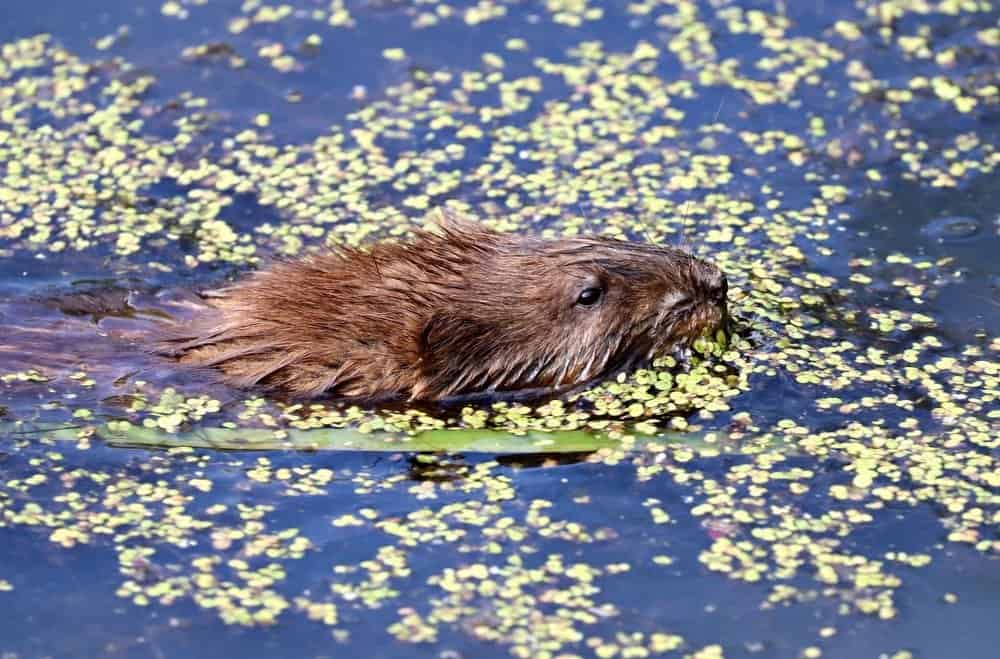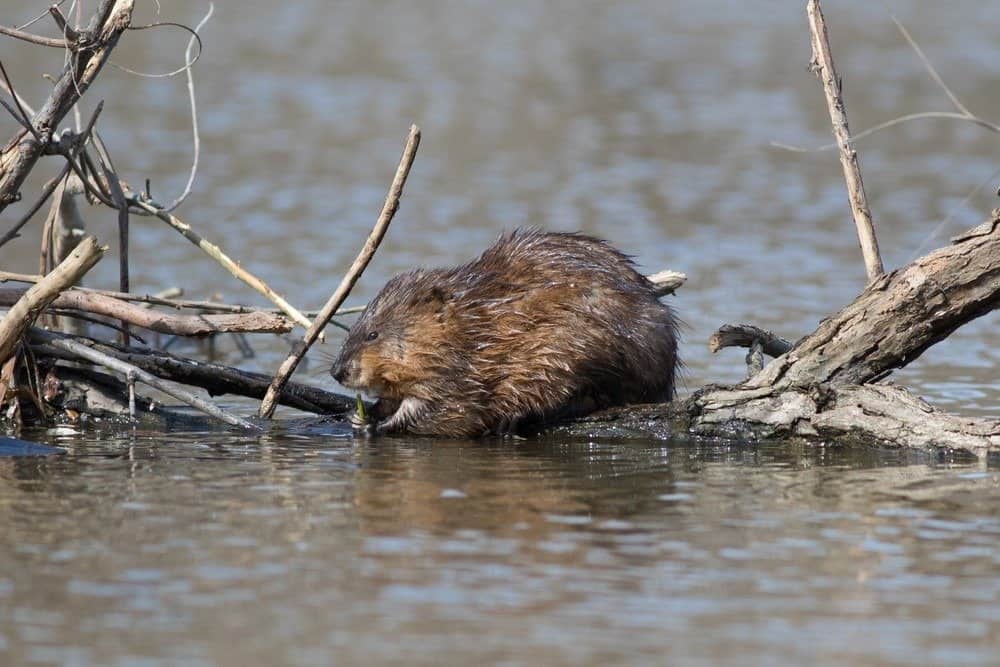Muskrats are semi-aquatic rodents native to North America. Similar in appearance to a small beaver, muskrats live in wetlands and swamps and have been trapped for food and fur throughout their history. Although they aren’t eaten much in modern times, their pelts can be valuable but are considered by many to be pests. Being so widespread in North American (and later introduced to Europe), many people are curious about these common animals. Let’s learn exactly what muskrats eat, as well as their dietary roles in the wild.
What do muskrats eat?

Muskrats are omnivores that eat aquatic vegetation and small animals like
frogs
, fish, and small turtles.
©Sergey Uryadnikov/Shutterstock.com
Muskrats eat cattails, aquatic plants, fish, frogs, crayfish, and other small animals.
As omnivores, muskrat eat both plants and animals, although they generally prioritize aquatic plants. As the name would lead you to believe, muskrats are rodents and share a similar diet. In short, they eat pretty much anything.
In their natural environment, muskrat primarily eat aquatic vegetation. Their favorite food source is cattail, a reed-like plant that can be found anywhere near water. Hybrid cattails have recently become invasive, taking over parts of the United States. Muskrats are an important ecological stopper to the widespread devastation these plants can bring. Aside from food, they also use cattails to build their nests and homes. A fun fact is that cattail shoots are edible for humans and were used as a food source for Native American tribes.
Aside from cattails, muskrats eat sedges, rushes, water lilies, and pond weeds. Their diet is 95% vegetation and helps keep waterways clear from overwhelming vegetation, although there are environmental problems associated with muskrats themselves. When muskrats run out of plant food, they have no qualms about sneaking into your garden and clearing you out by morning.
Although muskrats eat aquatic vegetation for 95% of their diet, that still leaves 5% to examine. That 5% is mostly made up of small aquatic animals that are often found in their habitats. Some of the most common examples are freshwater muscles, crayfish, frogs, fish, and small turtles.
A complete list of foods that muskrats eat
Here is a complete list of the common foods muskrats will eat:
- cattails
- sedges
- rushes
- water lilies
- pond weeds
- freshwater muscles
- crayfish
- fish
- snails
- frogs
- small turtles
Muskrats eat an astonishing one-third of their body weight each day. With such high caloric needs, they are constantly on the lookout for any of their favorite foods.
Muskrats in the wild
The muskrat has been in North America for a very long time. Native American groups have held the muskrat in high regard for thousands of years. Many of their mythologies center around muskrats bringing mud up to help a Creator build the world. On a practical level, muskrat were used as a food and fur resource in the spring and winter. Today, they are still trapped for their pelts. The resulting pelts used to be dyed and sold under the name “Hudson seal” fur, as they were often trapped in the region surrounding Hudson Bay.
In the 20th century, muskrat were introduced to Europe and quickly spread across the northwest. Since their ecological distribution, they have been considered a pest. They can easily overeat vegetation in ecological regions they aren’t native.
Muskrats build homes out of vegetation and mud. Although humans have destroyed much of their habitat, they are adaptable and have begun claiming canals and human-made waterways as new territory.
Who competes with muskrats in the wild?

Muskrats eat one-third of their body weight in food a day.
©Steve Gillick/Shutterstock.com
Muskrats have many natural predators, as well as a few competitors in their ecological niche. As far as predators go, muskrats are prey for mink, foxes, coyotes, cougars, bears, eagles, hawks, owls, wolverines, snakes, and alligators. In the North American ecosystem, they are an essential element of the food pyramid. Many predators rely on muskrat populations year-round.
As far as competition goes, muskrats compete with other semi-aquatic dwellers for food. Among the most common are beavers and nutria. Beavers eat a few of the aquatic plants that muskrat do, creating some competition between the species. However, there also exists a beneficial relationship between the two. Muskrats will occasionally move into a beaver dam while it’s still occupied. For beavers, the relationship works because muskrats will alert the nearby family if there are any predators nearby. For muskrats, it’s a rent-free place to live!
Nutria are the primary competition for muskrats. They were introduced from South American for fur and have since become a real problem. Whereas muskrats are three to four pounds, nutria are much larger, weighing in up to twenty-two pounds. As non-native, nutria also damage the ecosystem in ways that native muskrats don’t. When nutria move into an area, they destroy the natural waterways where muskrats live, reducing muskrat populations sharply.
A third “competitor” to the muskrat is the Florida water rat (otherwise known as the round-tailed muskrat). Muskrat populations don’t extend into Florida, exactly where the round-tailed muskrats territory begins.
How do muskrats get their food?

Muskrats eat by dragging food into their dens, away from predators.
©William Levesque/Shutterstock.com
Muskrat aren’t necessarily predators as they get 95% of their diet from vegetation. Still, they have unique ways to acquire and consume their food.
Central to a muskrat’s life is its den. These dome-shaped homes can be 4 feet x 5 feet and house an entire family of muskrats. Additionally, they have separate dens that are used for various needs, particularly feeding.
When a muskrat locates a plant or animal it intends to consume, it doesn’t want to do so in the open. Muskrats are near the bottom of the mammal food chain, and any time spent outside is risky. Once it grabs its food, it swims underwater and comes up in one of its pre-built “feeding dens” to eat in peace.
Muskrats are crepuscular, meaning you are most likely to see a muskrat during the low-light periods of dawn and dusk. That’s also the time they are most active and “hunting.”
The photo featured at the top of this post is © Sergey Uryadnikov/Shutterstock.com
Thank you for reading! Have some feedback for us? Contact the AZ Animals editorial team.






